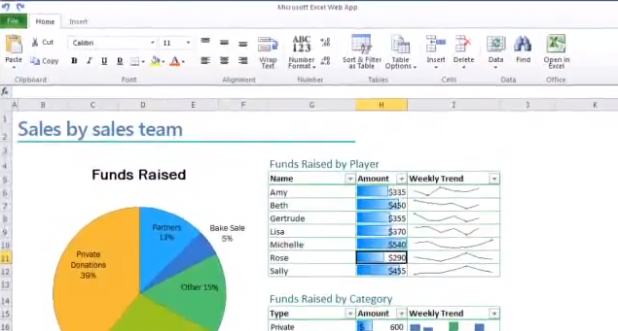 Microsoft is opening up Office Web Apps to more devices and browsers. “The full power of the Office Web Apps is already available for Windows 8 tablets and iPads,” read a May 7 posting on Microsoft’s Office blog, “and we will be extending the same capabilities to Android tablets via mobile Chrome browser support.” Office Web Apps (which launched in 2010) are also adding some other features, including real-time co-authoring. But the key thing here is that newfound Google Android compatibility. While Microsoft obviously hopes to expand Office Web Apps’ audience by porting it to the world’s most popular mobile-device OS, that porting can also be viewed as a preemptive attack of sorts on Google, which has displayed an increasing interest in building and marketing its own online productivity software. In the summer of 2012, Google acquired Quickoffice, a suite of cloud-based productivity software for mobile devices. A few months later, the company issued an update that made it easier to convert legacy Office files such as Word and Excel into Google Docs, Sheets, and Slides—all of them editable via Quickoffice. Workers can also open and edit Office files stored on Google Drive with the Quickoffice iPad app. If that wasn’t enough, Google is bringing Quickoffice to laptops, specifically its high-end Chromebook Pixel. The search-engine giant is clearly setting up the productivity software as an alternative to Microsoft’s Office; and while the latter still commands an impressive slice of the productivity software market, Google has the resources and corporate willpower to initiate some serious disruption if the right factors come together. So Microsoft retaliates with the best weapon in its arsenal: making Office more ubiquitous for more users on more platforms. Will that be enough to keep disruptive software at bay? That’s the several-billion-dollar question, and one that Microsoft surely wants answered in the affirmative. Image: Microsoft
Microsoft is opening up Office Web Apps to more devices and browsers. “The full power of the Office Web Apps is already available for Windows 8 tablets and iPads,” read a May 7 posting on Microsoft’s Office blog, “and we will be extending the same capabilities to Android tablets via mobile Chrome browser support.” Office Web Apps (which launched in 2010) are also adding some other features, including real-time co-authoring. But the key thing here is that newfound Google Android compatibility. While Microsoft obviously hopes to expand Office Web Apps’ audience by porting it to the world’s most popular mobile-device OS, that porting can also be viewed as a preemptive attack of sorts on Google, which has displayed an increasing interest in building and marketing its own online productivity software. In the summer of 2012, Google acquired Quickoffice, a suite of cloud-based productivity software for mobile devices. A few months later, the company issued an update that made it easier to convert legacy Office files such as Word and Excel into Google Docs, Sheets, and Slides—all of them editable via Quickoffice. Workers can also open and edit Office files stored on Google Drive with the Quickoffice iPad app. If that wasn’t enough, Google is bringing Quickoffice to laptops, specifically its high-end Chromebook Pixel. The search-engine giant is clearly setting up the productivity software as an alternative to Microsoft’s Office; and while the latter still commands an impressive slice of the productivity software market, Google has the resources and corporate willpower to initiate some serious disruption if the right factors come together. So Microsoft retaliates with the best weapon in its arsenal: making Office more ubiquitous for more users on more platforms. Will that be enough to keep disruptive software at bay? That’s the several-billion-dollar question, and one that Microsoft surely wants answered in the affirmative. Image: Microsoft Office Web Apps on Android Is Microsoft’s Google Counterattack
 Microsoft is opening up Office Web Apps to more devices and browsers. “The full power of the Office Web Apps is already available for Windows 8 tablets and iPads,” read a May 7 posting on Microsoft’s Office blog, “and we will be extending the same capabilities to Android tablets via mobile Chrome browser support.” Office Web Apps (which launched in 2010) are also adding some other features, including real-time co-authoring. But the key thing here is that newfound Google Android compatibility. While Microsoft obviously hopes to expand Office Web Apps’ audience by porting it to the world’s most popular mobile-device OS, that porting can also be viewed as a preemptive attack of sorts on Google, which has displayed an increasing interest in building and marketing its own online productivity software. In the summer of 2012, Google acquired Quickoffice, a suite of cloud-based productivity software for mobile devices. A few months later, the company issued an update that made it easier to convert legacy Office files such as Word and Excel into Google Docs, Sheets, and Slides—all of them editable via Quickoffice. Workers can also open and edit Office files stored on Google Drive with the Quickoffice iPad app. If that wasn’t enough, Google is bringing Quickoffice to laptops, specifically its high-end Chromebook Pixel. The search-engine giant is clearly setting up the productivity software as an alternative to Microsoft’s Office; and while the latter still commands an impressive slice of the productivity software market, Google has the resources and corporate willpower to initiate some serious disruption if the right factors come together. So Microsoft retaliates with the best weapon in its arsenal: making Office more ubiquitous for more users on more platforms. Will that be enough to keep disruptive software at bay? That’s the several-billion-dollar question, and one that Microsoft surely wants answered in the affirmative. Image: Microsoft
Microsoft is opening up Office Web Apps to more devices and browsers. “The full power of the Office Web Apps is already available for Windows 8 tablets and iPads,” read a May 7 posting on Microsoft’s Office blog, “and we will be extending the same capabilities to Android tablets via mobile Chrome browser support.” Office Web Apps (which launched in 2010) are also adding some other features, including real-time co-authoring. But the key thing here is that newfound Google Android compatibility. While Microsoft obviously hopes to expand Office Web Apps’ audience by porting it to the world’s most popular mobile-device OS, that porting can also be viewed as a preemptive attack of sorts on Google, which has displayed an increasing interest in building and marketing its own online productivity software. In the summer of 2012, Google acquired Quickoffice, a suite of cloud-based productivity software for mobile devices. A few months later, the company issued an update that made it easier to convert legacy Office files such as Word and Excel into Google Docs, Sheets, and Slides—all of them editable via Quickoffice. Workers can also open and edit Office files stored on Google Drive with the Quickoffice iPad app. If that wasn’t enough, Google is bringing Quickoffice to laptops, specifically its high-end Chromebook Pixel. The search-engine giant is clearly setting up the productivity software as an alternative to Microsoft’s Office; and while the latter still commands an impressive slice of the productivity software market, Google has the resources and corporate willpower to initiate some serious disruption if the right factors come together. So Microsoft retaliates with the best weapon in its arsenal: making Office more ubiquitous for more users on more platforms. Will that be enough to keep disruptive software at bay? That’s the several-billion-dollar question, and one that Microsoft surely wants answered in the affirmative. Image: Microsoft 

